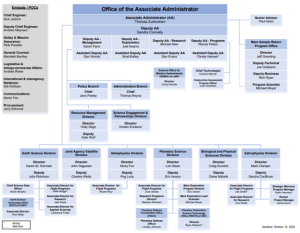Science
The requested FY 2023 budget for science ($7,988.3 billion) will be split between five different areas: Earth Science ($2,411.5 billion), Planetary Science ($3,160.2 billion), Astrophysics ($1,556 billion), Heliophysics ($760.2 million), and Biological and Physical Sciences ($100.4 million).[1]
Highlights:
- At $8 billion, this is the largest budget for Science ever.[2]
- The Earth Science budget will encompass NASA’s goal to ensure sustained climate observation provides ongoing records of the Earth system and the changing climate.[3]
- NASA has plans for an Earth Information Center which will focus, initially, on prototyping capabilities for greenhouse gas monitoring plus an information system that can combine data from various sources. The goal is to make information accessible and usable for Federal, State, and local governments, the public, researchers, and other users.[4]
- Funds for Planetary Science will be used to support two missions to investigate Venus: DAVINCI (Deep Atmosphere Venus Investigation of Noble gases, Chemistry, andImaging) and VERITAS (Venus Emissivity, Radio Science, InSAR, Topography, and Spectroscopy). The request also included funding for Europa Clipper, due to the impact of COVID. A two-year delay for the NEO Surveyer mission, as well as a discontinuation of funding for Mars Ice Mapper was included in the budget request.[5]
- The James Webb Space Telescope is now an operating mission within the Cosmic Origins Program.[6]
- It is proposed that the SOFIA mission close out in FY 2023. The high operating costs are not found to be justified by its low science productivity.[7]
- Space Weather Program is proposed within Heliophysics. The program will produce observations and data streams for modeling, theory, and data-driven analysis.[8]
- A new initiative within the Living With a Star Program called Orbital Debris & Space Situational Awareness (OD-SSA) is included. The program will focus on a knowledge gap of near-Earth space.[9]
- Space Biology investigations and facility development for conducting Soft Matter research in low-Earth orbit will be delayed. NASA is going to reassess the Biological and Physical Sciences portfolio after the 2023 Decadal Survey results are available.[10]
Office of the Associate Administrator Organization Chart:

Source: NASA
Updated November 2022, by Jackie Johnson

Comments are closed.